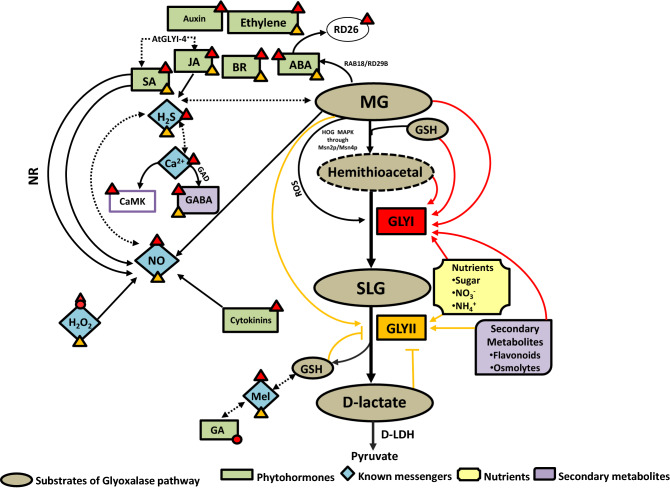Fig. 2.
Schematic representation of crosstalk among various molecules involved in signalling of glyoxalases in plants. Glyoxalase pathway mediated MG detoxification in plants is controlled by intricate mechanisms involving a plethora of signalling molecules such as phytohormones, messenger molecules, nutrients, reaction substrates and secondary metabolites. A crosstalk between these molecules facilitates optimal regulation of glyoxalases that are best suited for plant survival. Red and yellow arrows and/or arrowheads indicate upregulation of GLYI and GLYII, respectively whereas corresponding coloured circles and/or flatheads represent downregulation/inhibition, combination of arrowhead and circle represent both up and downregulation (as reports pertaining to both conditions available). NR, Nitrate reductase; CaMK, Calmodulin Kinase; GA, Gibberellin; JA, Jasmonic acid; ABA, Abscisic acid; SA, Salicylic acid; BR, Brassinosteroid; H2O2, Hydrogen peroxide; NO, Nitric oxide; H2S, Hydrogen sulphide; Ca2+, Calcium; Mel, Melatonin; NO3−, Nitrate; NH4+, Ammonia; MG, Methylglyoxal; GSH, reduced glutathione; SLG, S-D-lactoylglutathione; HOG-MAPK, High osmolarity glycerol-Mitogen activated protein kinase pathway; D-LDH, D-lactate Dehydrogenase; GABA, γ-Aminobutyric acid; GAD, Glutamate decarboxylase; ROS, Reactive Oxygen Species; GLYI, Glyoxalase I; GLYII, Glyoxalase II; RD26, Responsive to Desiccation 26; RAB18, Responsive to ABA 18; RD29B, Responsive to Desiccation 29B; Msn2p/Msn4p, Multicopy suppressor of SNF1 (Sucrose Non-fermentable) mutation 2/4p. Dashed line indicates synergistic interactions

